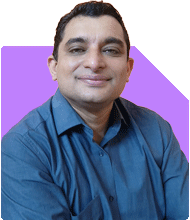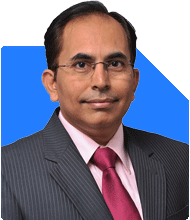How can I secure my future expenses and beat inflation with a 50-lakh investment?
Ramalingam Kalirajan |10902 Answers |Ask -Follow
Mutual Funds, Financial Planning Expert - Answered on Aug 12, 2024
He has an MBA in finance from the University of Madras and is a certified financial planner.
He is the director and chief financial planner at Holistic Investment, a Chennai-based firm that offers financial planning and wealth management advice.... more

Hi, I am 50 years old, single, with one sister, and I own my house. My job stability is uncertain, as it could last for 1, 2, or 3 years. I have secured ?30 lakhs in an FD as emergency funds, which can cover my monthly expenses of ?25,000. I am looking to invest ?40-50 lakhs into mutual funds over the next 3-4 years. My primary goal is to secure my future expenses while beating inflation. Please suggest me the suitable strategy to cover my future expenses, beat the inflation and wealth creation. • 40-50 lacs in Fix deposits. (To be deployed in mutual funds). • Medical Insurance 10 lacs base amount/65 lacs super top up. • 25 lacs invested in stocks. • 7.5 lacs in PPF (4000 Rs SIP every month). • 6 lacs NPS (approx.) (Want to get rid of the same due to its poor performance). • 5.5 lacs pension plan (ICICI) (Want to get rid of the same due to its poor performance). • 5 lacs ULIPS(ICICI) (Want to get rid of the same due to its poor performance). • 6 lacs EPFO (approx.). • Mutual Funds (10 lacs approx.). • CANARA ROBECOCONSERVATIVE HYBRID FUND-DIRECT GROWTH. (INVESTED 1 LAC IN 2020). • KOTAK DBT HYBRID FUND-DIRECT GROWTH (INVESTED 5 LACS IN 2024). • TATA ELSS TAX SAVER FUND-DIRECT GROWTH (CURRENT VALUE 3 LACS APPROX). • NIPPON INDIA DYNAMIC BOND FUND-DIRECT GROWTH (INVESTED 2 LACS IN 2020).
Given your goals of beating inflation, securing future expenses, and wealth creation, let’s explore a strategy to align your investments with these objectives.
Emergency Fund and Job Stability
Your Rs 30 lakh FD acts as an emergency fund, covering over 10 years of expenses at Rs 25,000 per month. This is a robust safety net, especially given your job uncertainty.
Liquidity: Keep a portion of this FD liquid to ensure quick access in case of job loss or unexpected expenses.
Staggered FD Approach: Consider breaking your FD into multiple deposits with varying maturity dates. This will give you liquidity at regular intervals without sacrificing interest.
Medical Insurance
Your medical insurance coverage is substantial, with Rs 10 lakhs as the base amount and Rs 65 lakhs as a super top-up. This provides excellent coverage for potential medical expenses.
Regular Review: Ensure your medical insurance is reviewed annually. Medical inflation is high, and adequate coverage is vital as you age.
Optimizing Your Existing Investments
1. Fixed Deposits (Rs 40-50 lakhs)
You plan to deploy Rs 40-50 lakhs from FDs into mutual funds over the next 3-4 years. This is a wise move to combat inflation and seek higher returns.
Systematic Transfer Plan (STP): Consider using an STP to gradually move funds from FDs to equity mutual funds. This reduces the risk of entering the market at a high point and provides a steady investment approach.
Hybrid Funds: Since you’re transitioning from FDs, you may start with hybrid funds, which offer a mix of equity and debt. They provide growth potential with some stability.
2. Stocks (Rs 25 lakhs)
Your Rs 25 lakh investment in stocks needs careful management, especially with your retirement approaching.
Diversification: Ensure your stock portfolio is well-diversified across sectors. Avoid overexposure to any single industry.
Professional Management: Consider reallocating a portion of your stocks to professionally managed equity mutual funds. Fund managers can help optimize returns and reduce risk, which is crucial as you near retirement.
3. Public Provident Fund (PPF - Rs 7.5 lakhs)
PPF is a safe and tax-efficient investment, ideal for long-term goals.
Continue SIP: Keep your Rs 4,000 SIP in PPF. It offers assured returns and tax benefits under Section 80C, making it a valuable component of your portfolio.
Partial Withdrawals: Remember, you can make partial withdrawals after 15 years if needed, making it a flexible option for future needs.
4. National Pension System (NPS - Rs 6 lakhs)
You’ve mentioned dissatisfaction with NPS due to its performance. While it’s a long-term investment, the returns may not align with your expectations.
Exit Strategy: If you’re considering exiting NPS, be mindful of the exit rules and tax implications. You could use the proceeds to invest in more growth-oriented funds.
Alternative Investment: Consider shifting the funds to a balanced or equity-oriented mutual fund for potentially better returns.
5. Pension Plan (Rs 5.5 lakhs) and ULIPs (Rs 5 lakhs)
You want to exit your ICICI pension plan and ULIPs due to poor performance. These products often have high costs and lower returns compared to mutual funds.
Surrender Strategy: Evaluate the surrender charges and potential losses before exiting. It might be worth exiting if the charges are reasonable.
Reinvestment: Reinvest the surrendered amount in mutual funds, where you can potentially achieve better growth with lower costs.
6. Employees’ Provident Fund Organisation (EPFO - Rs 6 lakhs)
EPFO is a secure investment that provides decent returns along with tax benefits.
Continue Contributions: Keep contributing to EPFO if possible. It’s a safe investment with the added benefit of retirement savings.
Rebalancing: As you approach retirement, gradually shift from equity to debt to preserve your capital.
New Investment Strategy
1. Equity Mutual Funds
Equity mutual funds are essential for long-term growth. Given your 3-4 year investment horizon for Rs 40-50 lakhs, start with a mix of large-cap and multi-cap funds.
Large-Cap Funds: These funds invest in well-established companies, offering stability and moderate growth. They are less volatile and provide steady returns.
Multi-Cap Funds: These funds provide exposure to large, mid, and small-cap companies, offering a balanced approach to growth and risk.
2. Balanced Funds
Balanced funds can be an excellent choice for someone transitioning from fixed deposits. They offer a mix of equity and debt, providing both growth and stability.
Moderate Risk: Balanced funds are ideal if you seek growth but with controlled risk. They can provide better returns than FDs while managing volatility.
3. Dynamic Bond Funds
Your investment in the Nippon India Dynamic Bond Fund indicates an interest in debt mutual funds. Dynamic bond funds can adjust their portfolio based on interest rate movements, which makes them a good option for fixed-income investments.
Interest Rate Management: These funds are actively managed to take advantage of changing interest rates, potentially offering better returns than traditional debt funds.
Final Insights
Your financial plan should focus on securing your future while beating inflation. Transitioning Rs 40-50 lakhs from fixed deposits to mutual funds over 3-4 years is a wise move. Use an STP to manage risk, and consider equity and balanced funds for growth.
Your existing investments in PPF, EPFO, and stocks should be managed carefully, with a focus on diversification and risk management. Exit underperforming products like NPS, pension plans, and ULIPs if it makes financial sense. Reinvest those funds into better-performing mutual funds.
Regularly review and rebalance your portfolio to stay aligned with your goals. Given your age and financial situation, a mix of equity and debt will provide growth, security, and inflation protection.
Best Regards,
K. Ramalingam, MBA, CFP,
Chief Financial Planner,
www.holisticinvestment.in
You may like to see similar questions and answers below
Ramalingam Kalirajan |10902 Answers |Ask -Follow
Mutual Funds, Financial Planning Expert - Answered on Apr 08, 2024
Ramalingam Kalirajan |10902 Answers |Ask -Follow
Mutual Funds, Financial Planning Expert - Answered on May 01, 2024
Ramalingam Kalirajan |10902 Answers |Ask -Follow
Mutual Funds, Financial Planning Expert - Answered on Oct 03, 2024
Ramalingam Kalirajan |10902 Answers |Ask -Follow
Mutual Funds, Financial Planning Expert - Answered on Jun 13, 2025
Ramalingam Kalirajan |10902 Answers |Ask -Follow
Mutual Funds, Financial Planning Expert - Answered on Aug 04, 2025
Anu Krishna |1749 Answers |Ask -Follow
Relationships Expert, Mind Coach - Answered on Dec 17, 2025
Anu Krishna |1749 Answers |Ask -Follow
Relationships Expert, Mind Coach - Answered on Dec 17, 2025
Radheshyam Zanwar |6748 Answers |Ask -Follow
MHT-CET, IIT-JEE, NEET-UG Expert - Answered on Dec 17, 2025
Anu Krishna |1749 Answers |Ask -Follow
Relationships Expert, Mind Coach - Answered on Dec 17, 2025
Dr Shakeeb Ahmed Khan |184 Answers |Ask -Follow
Physiotherapist - Answered on Dec 17, 2025
T S Khurana |538 Answers |Ask -Follow
Tax Expert - Answered on Dec 17, 2025
T S Khurana |538 Answers |Ask -Follow
Tax Expert - Answered on Dec 17, 2025
Janak Patel |72 Answers |Ask -Follow
MF, PF Expert - Answered on Dec 17, 2025
Ramalingam Kalirajan |10902 Answers |Ask -Follow
Mutual Funds, Financial Planning Expert - Answered on Dec 17, 2025
Samraat Jadhav |2511 Answers |Ask -Follow
Stock Market Expert - Answered on Dec 17, 2025


























